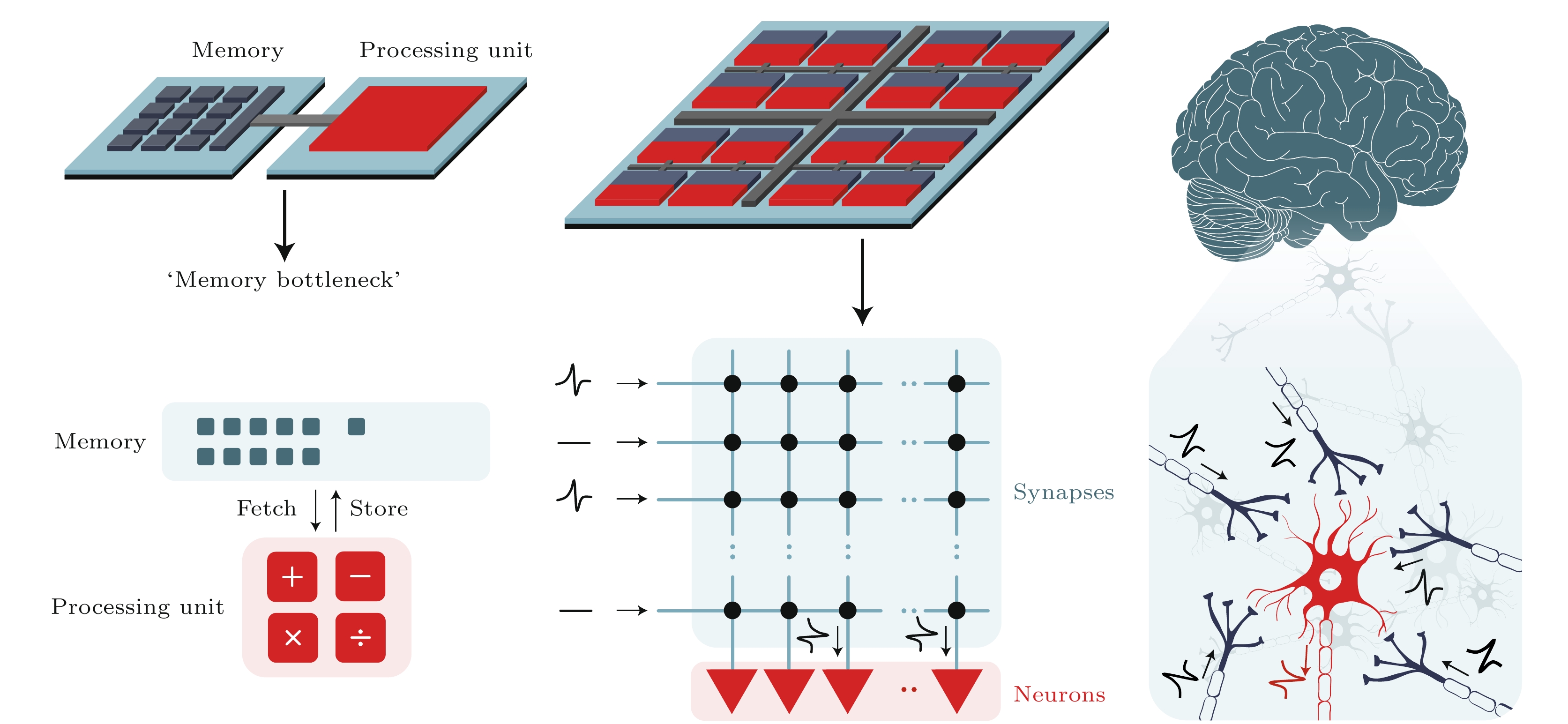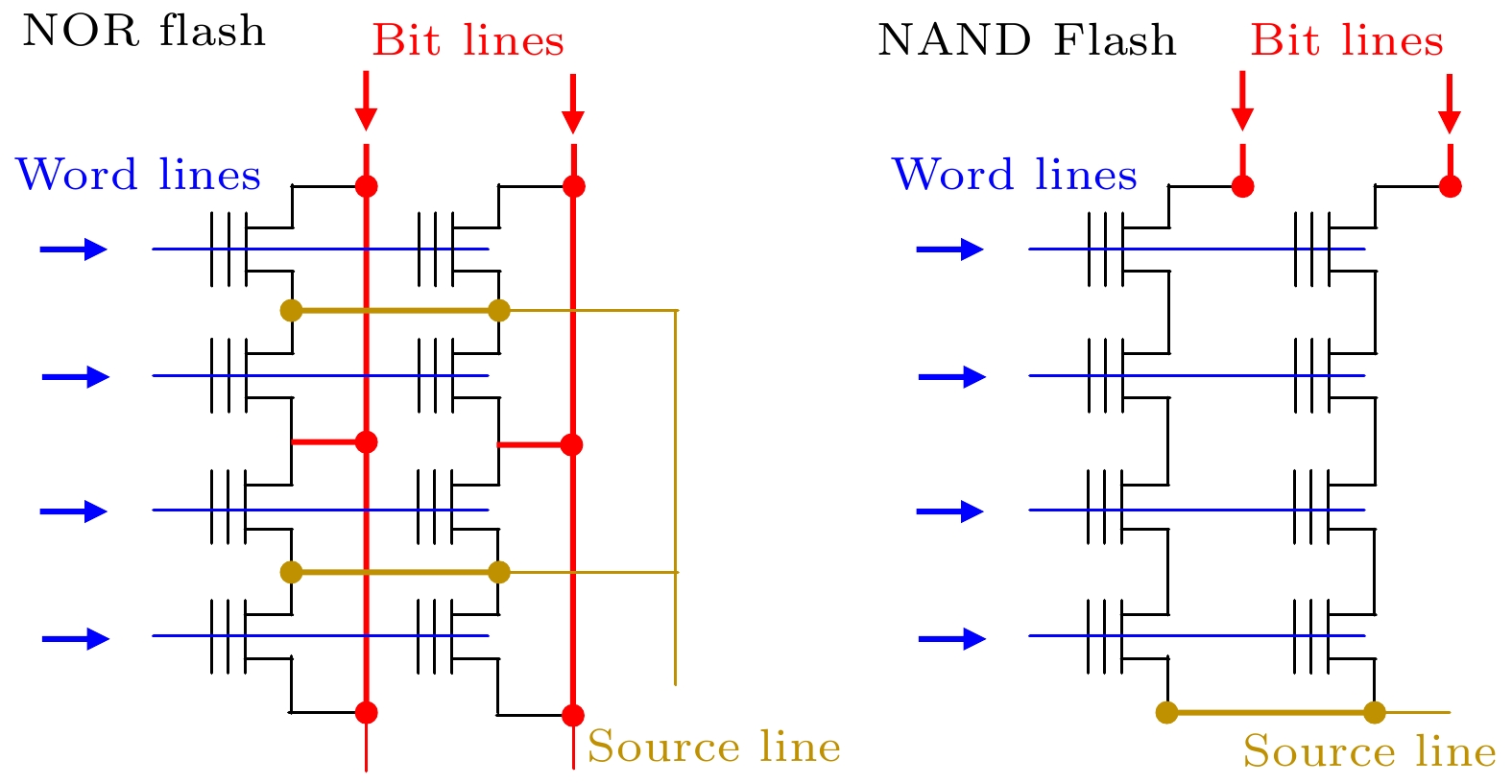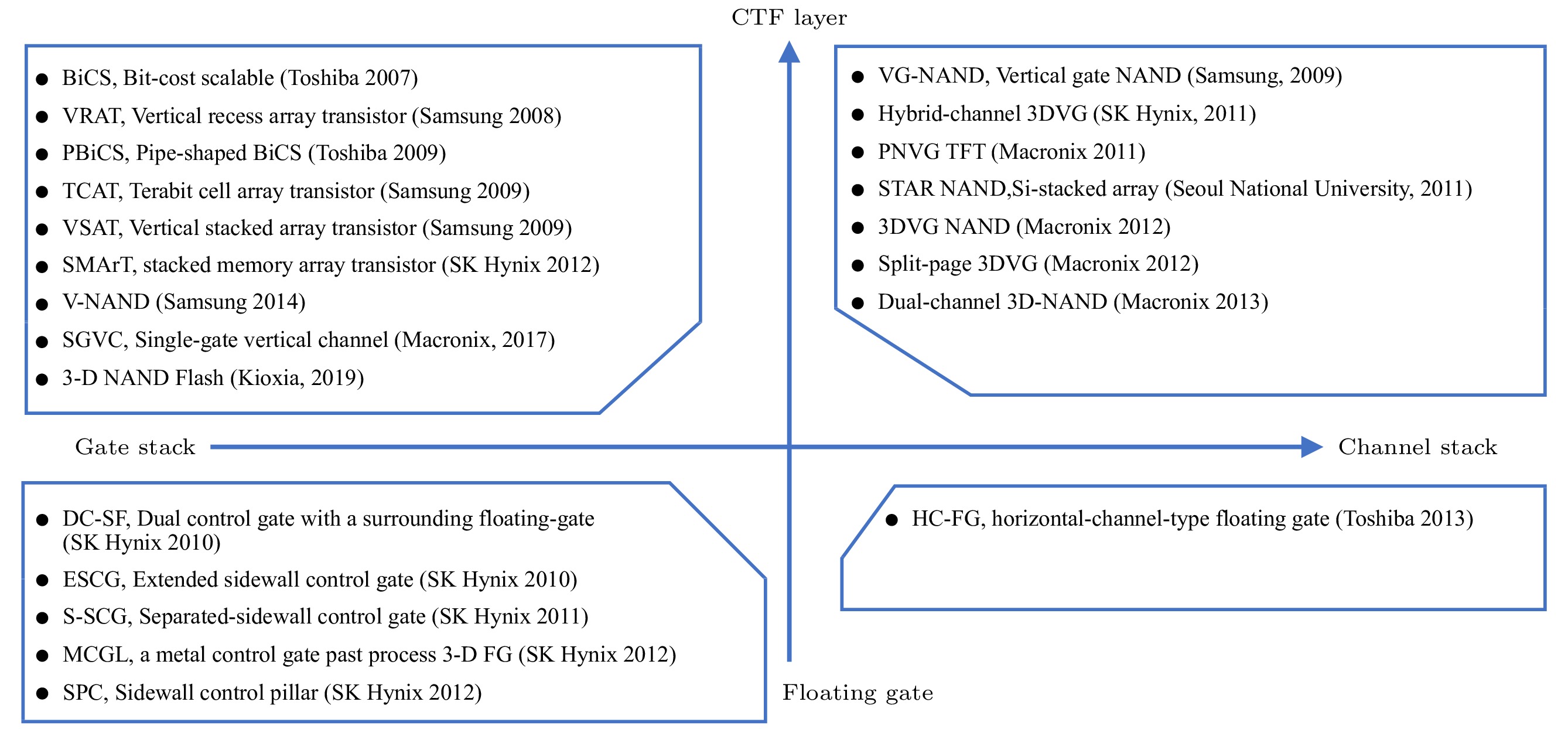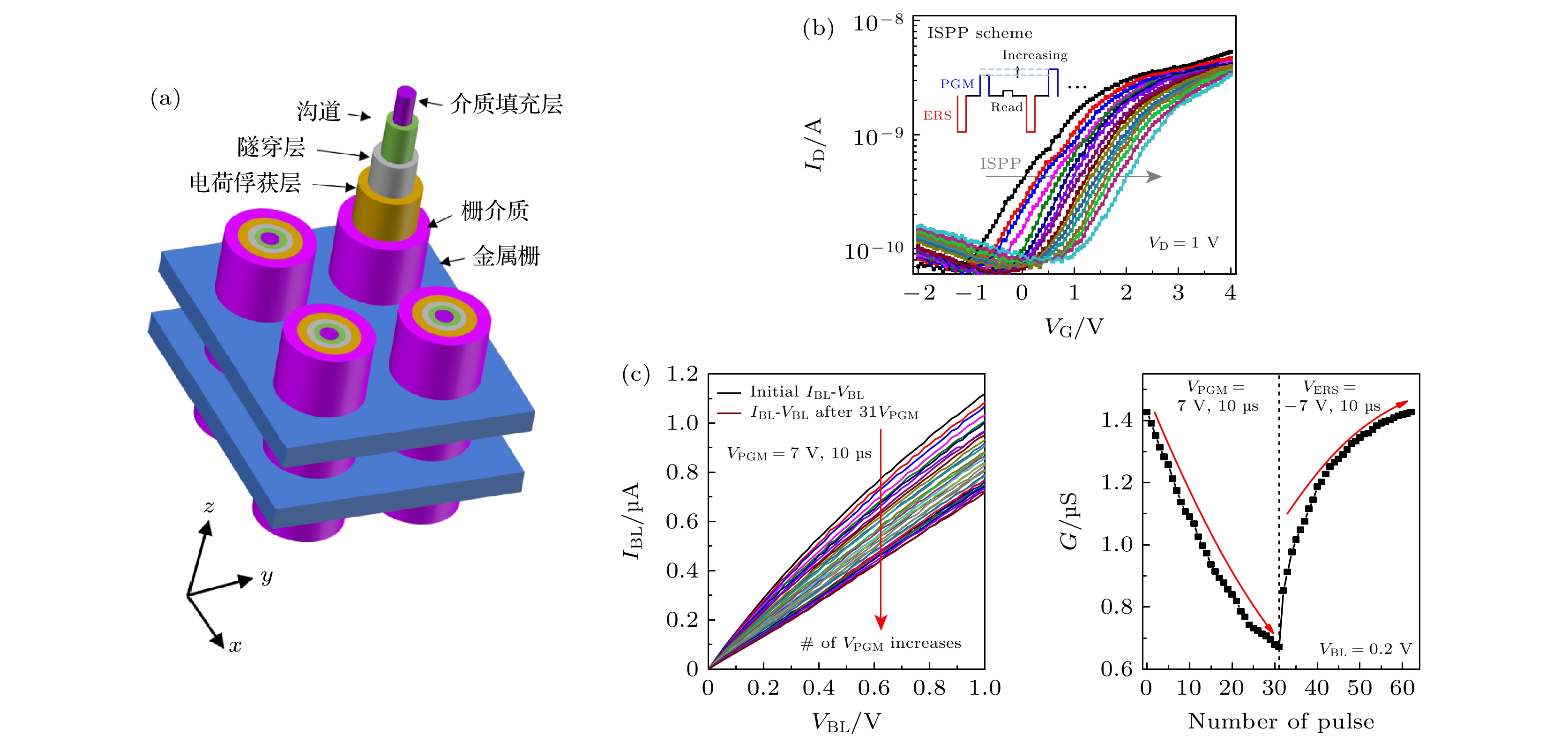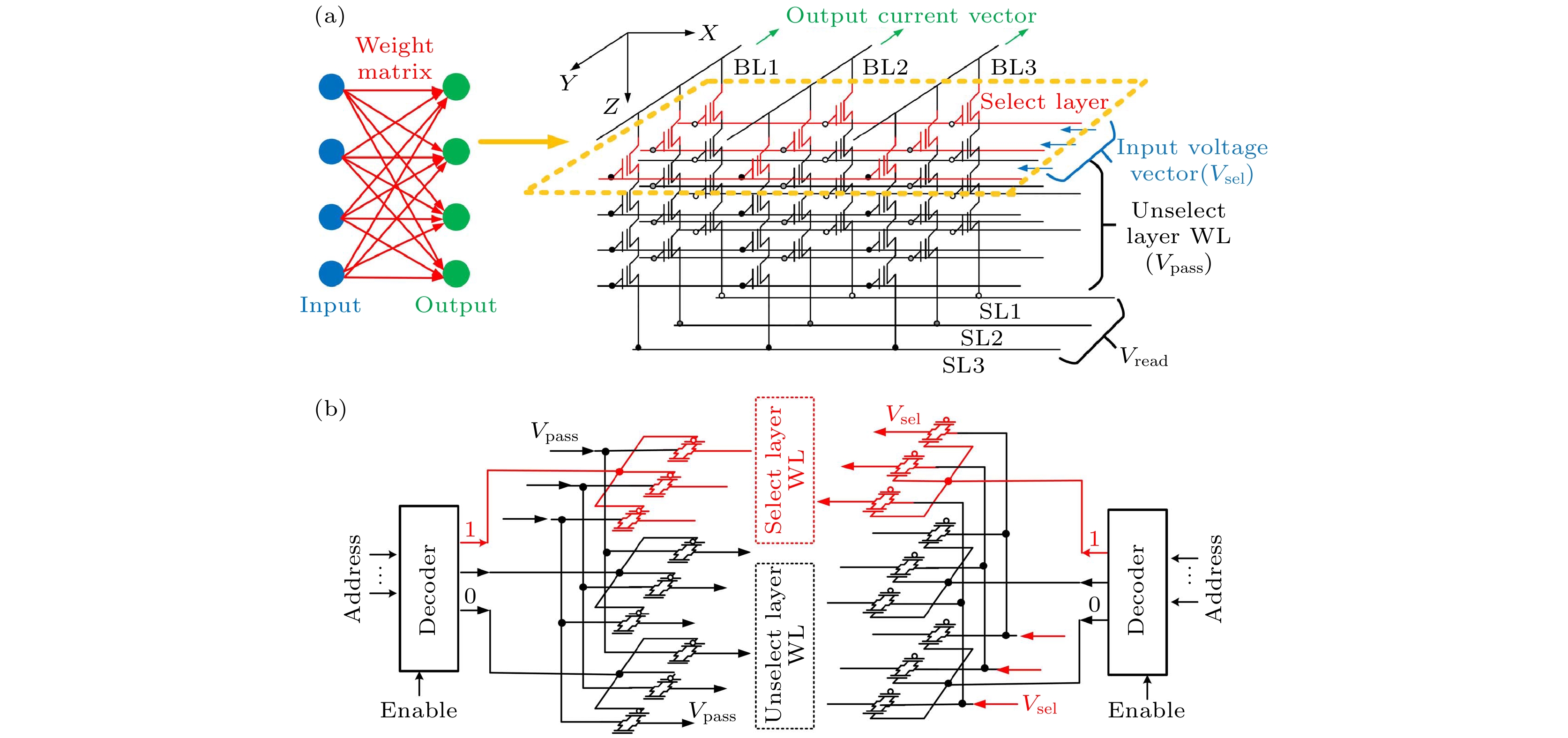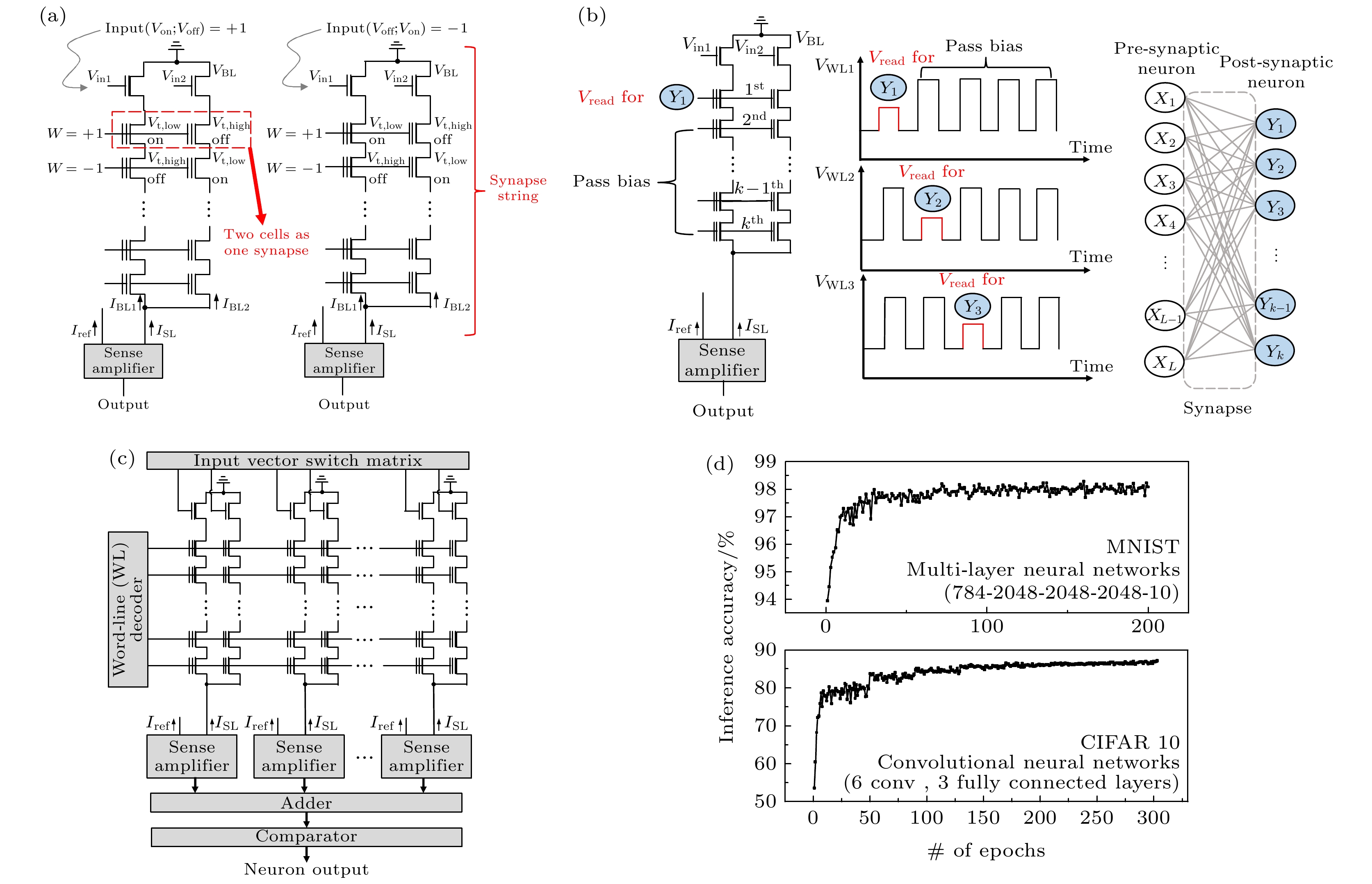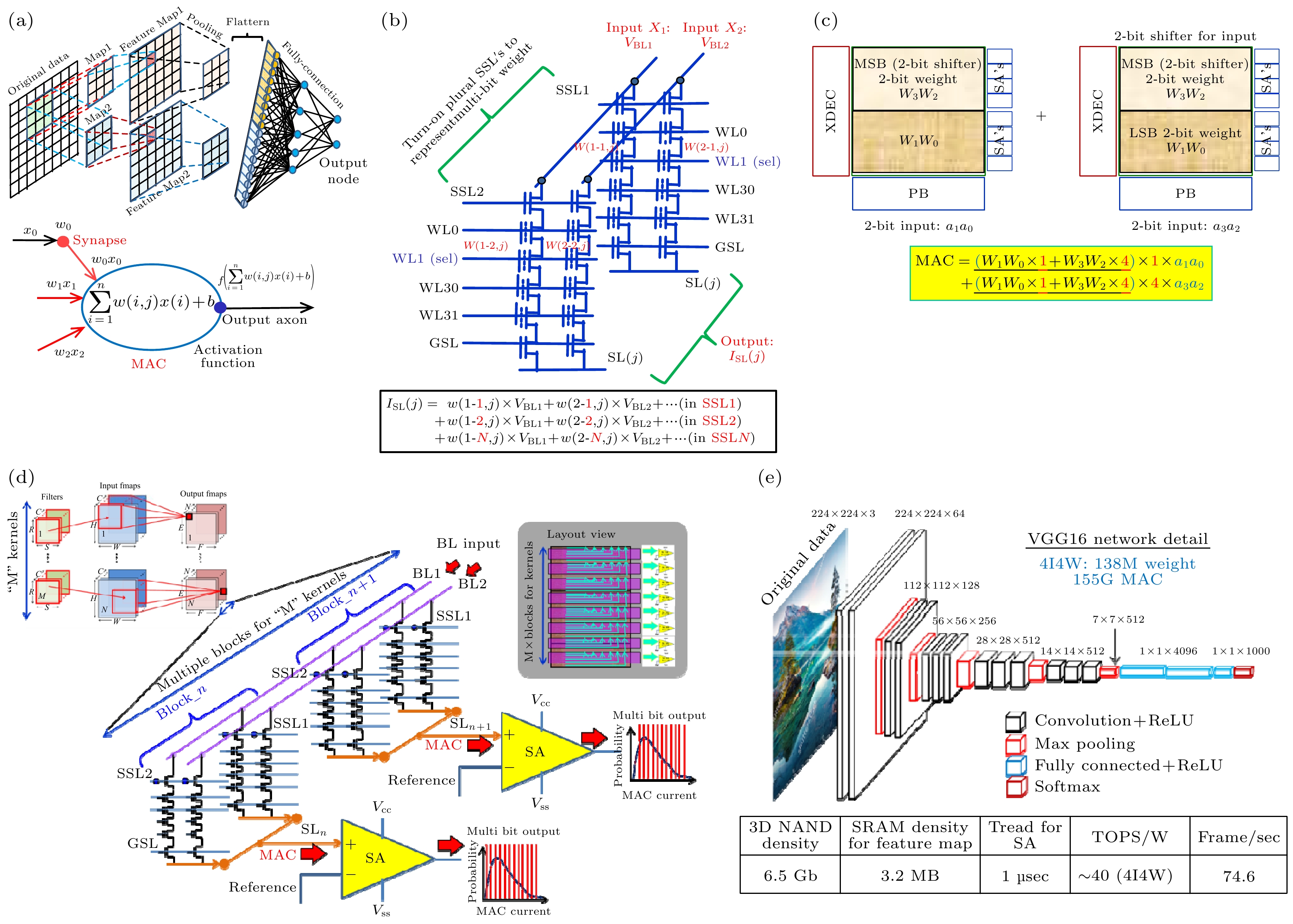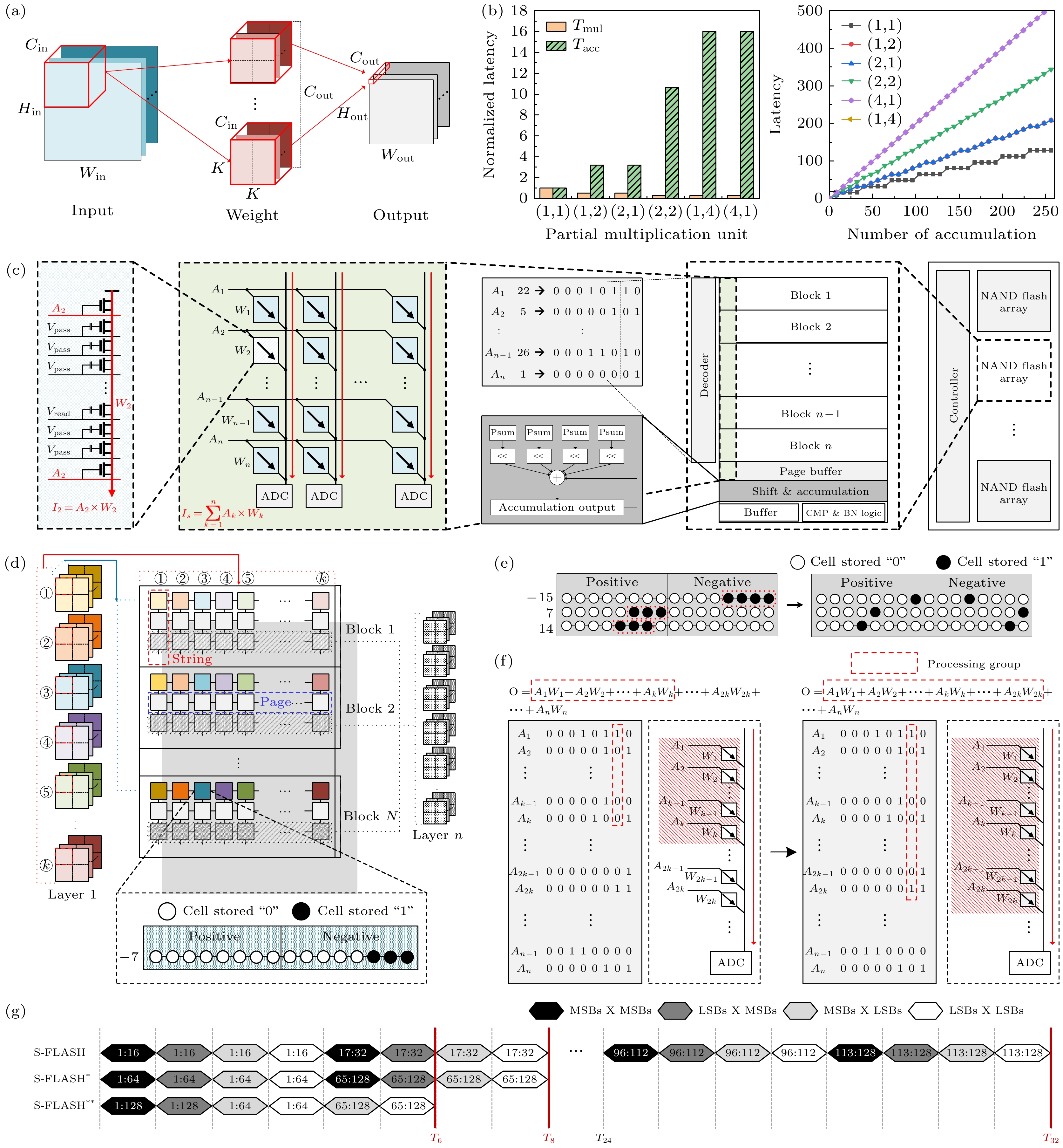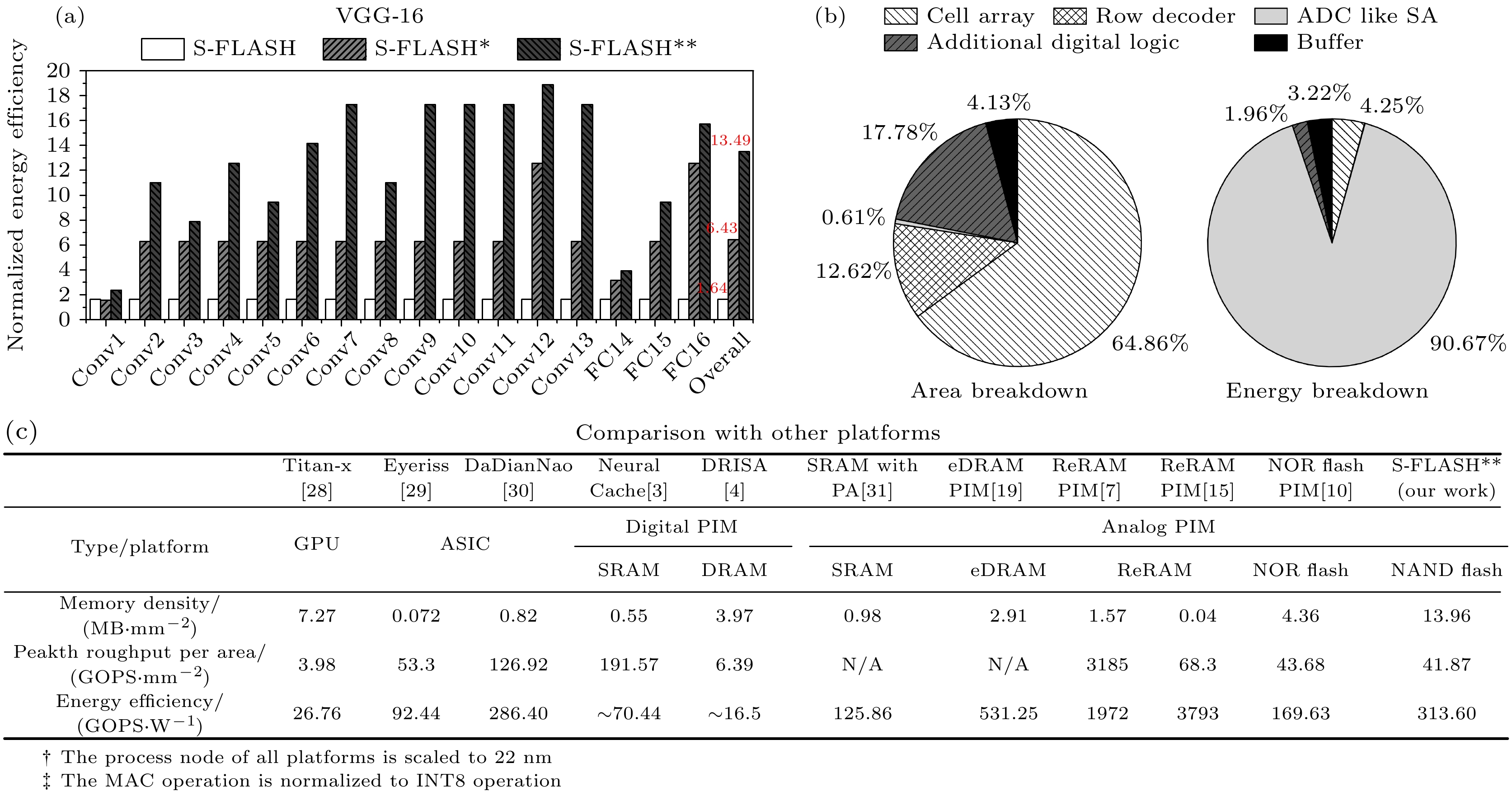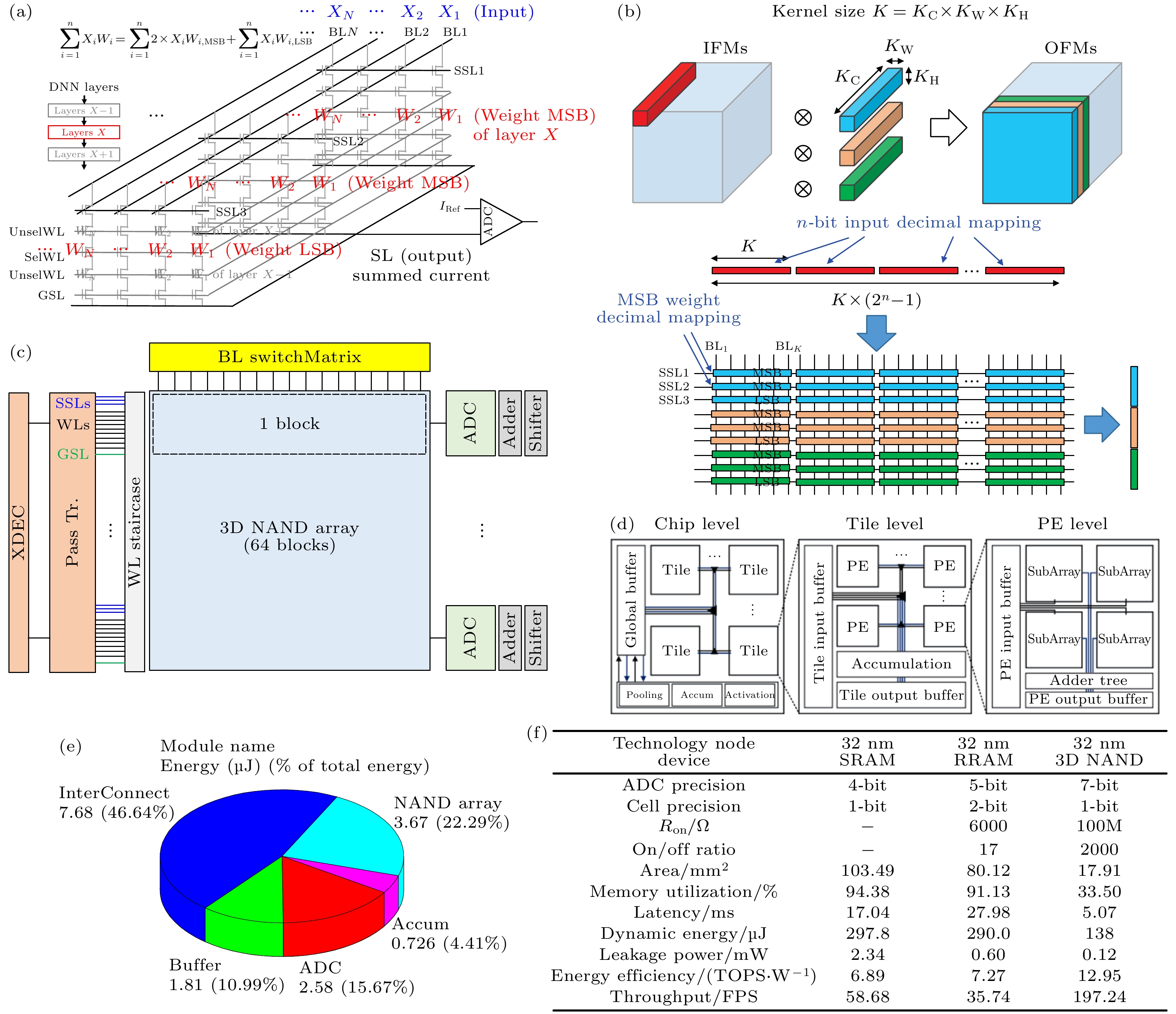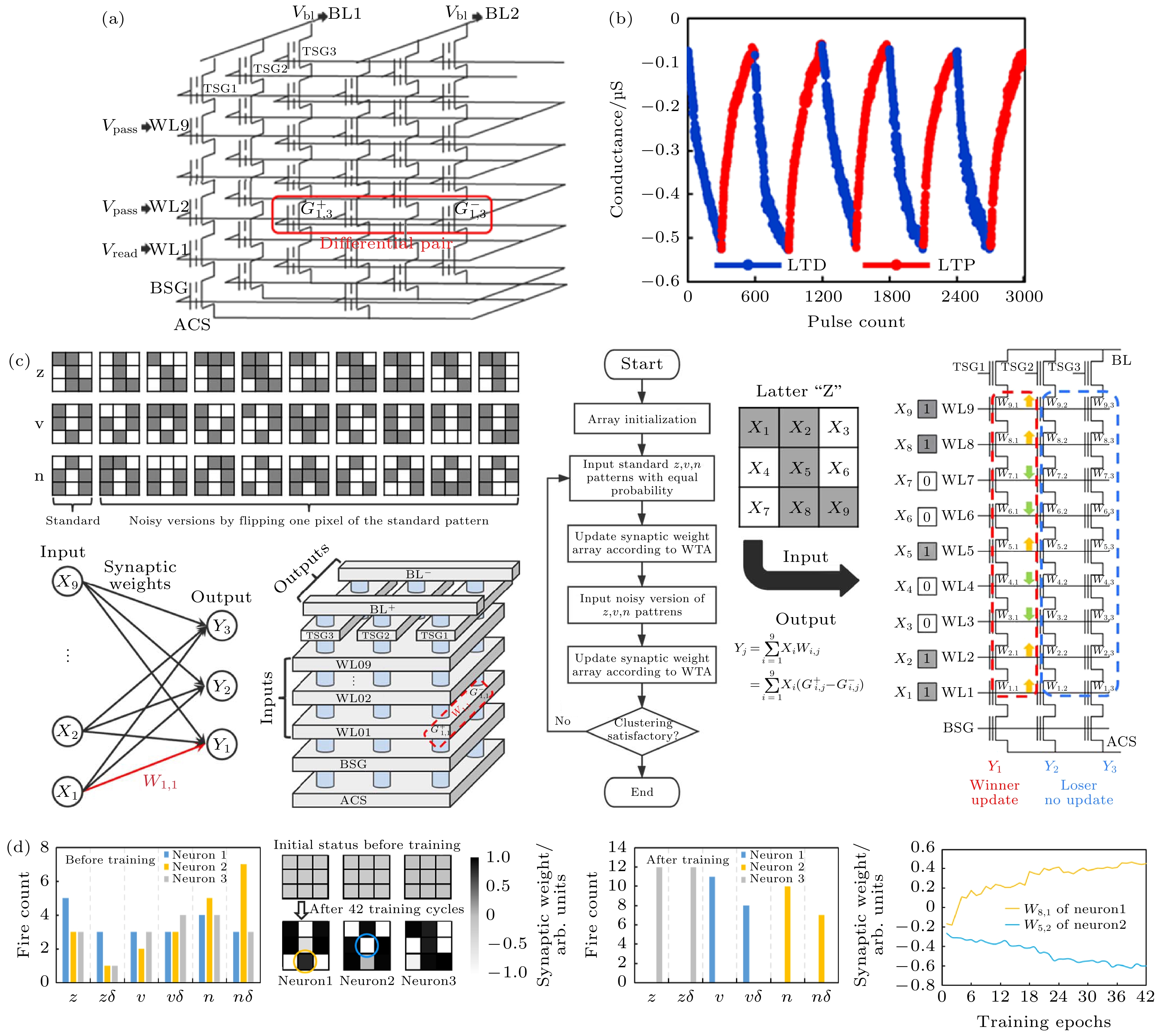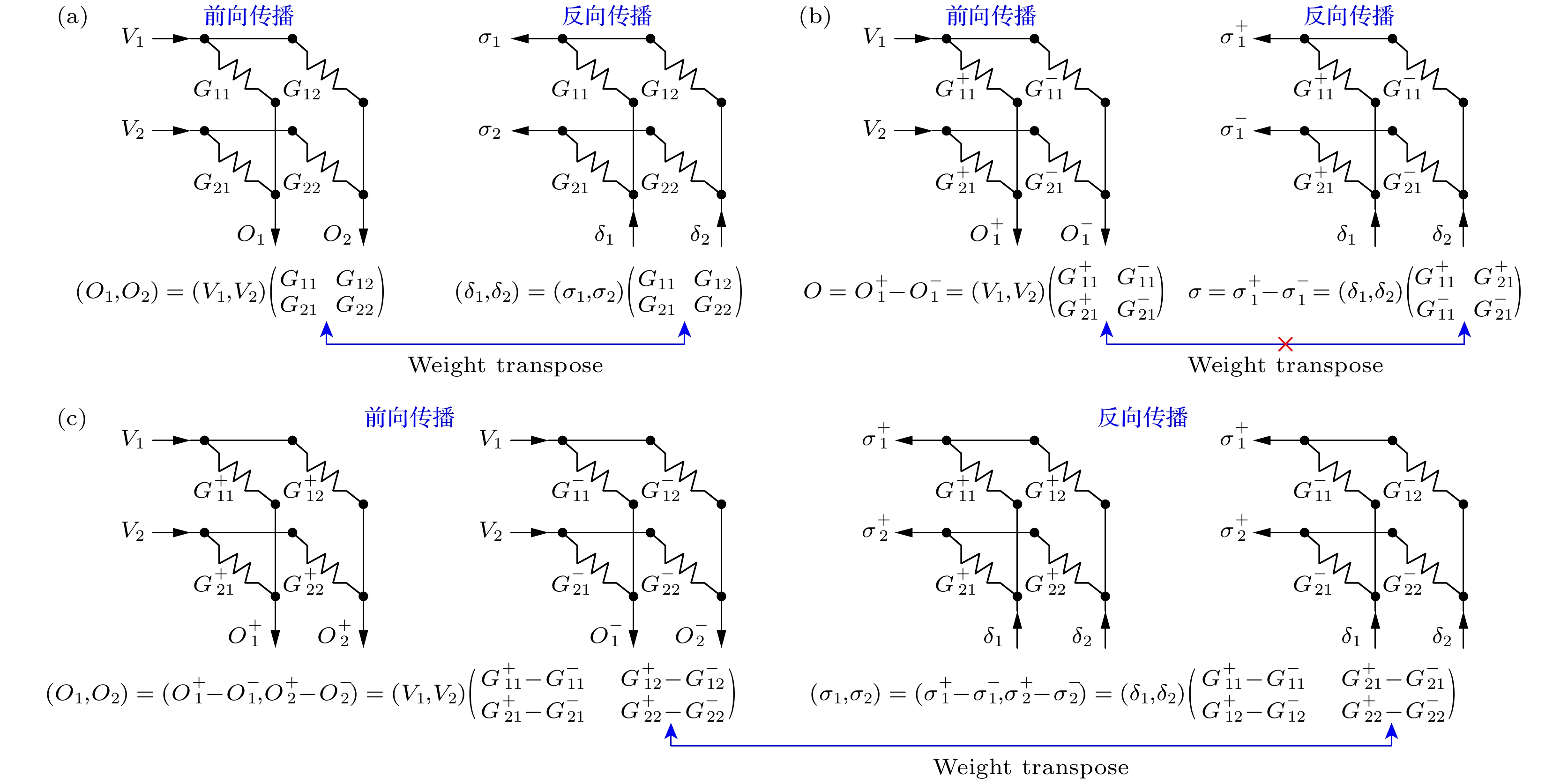-
A neuromorphic chip is an emerging AI chip. The neuromorphic chip is based on non-Von Neumann architecture, and it simulates the structure and working principle of the human brain. Compared with non-Von Neumann architecture AI chips, the neuromorphic chips have significant improvement of efficiency and energy consumption advantages. The 3D-NAND flash memory has the merits of a mature process and ultra-high storage density, and recently it attracted many researchers’ attention. However, owing to the proprietary nature of the technology, there are few hardware implementations. This paper reviews the present research status of neuromorphic computing by using the 3D-NAND flash memory, introduces the forward propagation and backward propagation schemes, and proposes several improvements on the device, structure, and architecture of 3D NAND for neuromorphic computing.
-
Keywords:
- neuromorphic computing /
- 3D-NAND /
- in-memory computing architecture
[1] Amodei D, Hernandez D, Sastry G, Clark J, Brockman G, Sutskever I https://openai.com/blog/ai-and-compute/ [2022-4-11]
[2] Patterson D A, Hennessy J L 2021 Computer Organization and Design RISC-V Edition: the Hardware Software Interface (6th Ed.) (Amsterdam: Morgan Kaufmann) p44
[3] Gai S https://pensando.io/dennard-scaling-and-other-power-considerations/ [2022-4-11]
[4] Dally B https://www.cs.colostate.edu/~cs575dl/Sp2015/Lectures/Dally2015.pdf [2022-4-11]
[5] Drachman D A 2005 Neurology 64 2004
 Google Scholar
Google Scholar
[6] Zhang W, Gao B, Tang J, Yao P, Yu S, Chang M F, Yoo H J, Qian H, Wu H 2020 Nat. Electron. 3 371
 Google Scholar
Google Scholar
[7] Roy K, Jaiswal A, Panda P 2019 Nature 575 607
 Google Scholar
Google Scholar
[8] Khaddam-Aljameh R, Stanisavljevic M, Mas J F, et al. 2021 2021 Symposium on VLSI Technology Kyoto, Japan, June 13–19, 2021 p1
[9] Narayanan P, Ambrogio S, Okazaki A, et al. 2021 2021 Symposium on VLSI Technology Kyoto, Japan, June 13–19, 2021 p1
[10] Yang J, Xue X, Xu X, Lv H, Zhang F, Zeng X, Chang M F, Liu M 2020 2020 IEEE Symposium on VLSI Circuits Honolulu, HI, USA, June 16–19, 2020 p1
[11] Chih Y D, Shih Y C, Lee C F, et al.2020 2020 IEEE International Solid-State Circuits Conference San Francisco, CA, USA, Feb 16–20, 2020 p222
[12] Liu Y, Su F, Yang Y, Wang Z, Wang Y, Li Z, Li X, Yoshimura R, Naiki T, Tsuwa T, Saito T, Wang Z, Taniuchi K, Yang H 2019 IEEE J. Solid-State Circuits 54 885
 Google Scholar
Google Scholar
[13] Dünkel S, Trentzsch M, Richter R, et al. 2017 2017 IEEE International Electron Devices Meeting San Francisco, California, USA, Dec 2–6, 2017, p19.17. 11
[14] IRDSTM 2021 International Roadmap for Devices and Systems (2021 Ed.) (IEEE) from https://irds.ieee.org/images/files/pdf/2021/2021IRDS_MM_Tables.xlsx [2022-4-11]
[15] Liu T Y, Yan T H, Scheuerlein R, et al. 2013 2013 IEEE International Solid-State Circuits Conference San Francisco, CA, USA, Feb. 17–21, 2013 p210
[16] Chen Y, Li H, Wang X, Zhu W, Xu W, Zhang T 2012 IEEE J. Solid-State Circuits 47 560
 Google Scholar
Google Scholar
[17] Rho K, Tsuchida K, Kim D, et al. 2017 2017 IEEE International Solid-State Circuits Conference San Franciso, CA, USA, Feb. 5–9, 2017 p396
[18] Zwerg M, Baumann A, Kuhn R, et al. 2011 2011 IEEE International Solid-State Circuits Conference San Francisco, CA, USA, Feb. 20–24, 2011 p334
[19] Takashima D, Nagadomi Y, Ozaki T 2011 IEEE J. Solid-State Circuits 46 681
 Google Scholar
Google Scholar
[20] Trentzsch M, Flachowsky S, Richter R, et al. 2016 2016 IEEE International Electron Devices Meeting San Francisco, CA, USA, December 3–7, 2016 p11.15.11
[21] Lee J W, Na D, Kavala A, et al. 2020 2020 IEEE Symposium on VLSI Circuits Honolulu, HI, United States, June 16–19, 2020 p1
[22] Mulaosmanovic H, Breyer E T, Dünkel S, Beyer S, Mikolajick T, Slesazeck S 2021 Nanotechnology 32 502002
 Google Scholar
Google Scholar
[23] Noguchi H, Ikegami K, Kushida K, et al. 2015 2015 IEEE International Solid-State Circuits Conference San Franciso, CA, USA, February 22–26, 2015 p1
[24] Sato H, Honjo H, Watanabe T, et al. 2018 2018 IEEE International Electron Devices Meeting San Francisco, CA, USA, December 1–5, 2018 p27.22.21
[25] Khan A I, Keshavarzi A, Datta S 2020 Nat. Electron. 3 588
 Google Scholar
Google Scholar
[26] Dong Q, Kim Y, Lee I, et al. 2017 2017 IEEE International Solid-State Circuits Conference San Francisco, CA, USA, February 5–9 2017 p198
[27] Cheong W, Yoon C, Woo S, et al. 2018 2018 IEEE International Solid-State Circuits Conference San Francisco, California, USA, February 11–15, 2018 p338
[28] Liang J, Jeyasingh R G D, Chen H, Wong H P 2011 2011 Symposium on VLSI Technology Kyoto, Japan, June 14–16, 2011 p100
[29] Wu T F, Le B Q, Radway R, et al. 2019 2019 IEEE International Solid-State Circuits Conference San Francisco, CA, USA, February 17–21, 2019 p226
[30] Dong Q, Wang Z, Lim J, Zhang Y, Sinangil M E, Shih Y C, Chih Y D, Chang J, Blaauw D, Sylvester D 2019 IEEE J. Solid-State Circuits 54 231
 Google Scholar
Google Scholar
[31] [32] Sandre G D, Bettini L, Pirola A, et al. 2010 2010 IEEE International Solid-State Circuits Conference San Francisco, California, USA, February 7–11, 2010 p268
[33] Lo C P, Lin W Z, Lin W Y, Lin H T, Yang T H, Chiang Y N, King Y C, Lin C J, Chih Y D, Chang T Y J, Chang M F 2019 IEEE J. Solid-State Circuits 54 584
 Google Scholar
Google Scholar
[34] Xue X Y, Jian W X, Yang J G, Xiao F J, Chen G, Xu X L, Xie Y F, Lin Y Y, Huang R, Zhou Q T, Wu J G 2012 2012 Symposium on VLSI Circuits Honolulu, HI, USA, June 13–15, 2012 p42
[35] Chang M, Shen S, Liu C, Wu C, Lin Y, King Y, Lin C, Liao H, Chih Y, Yamauchi H 2013 IEEE J. Solid-State Circuits 48 864
[36] Chen J, Chiang R C, Huang H H, Venkataramani G 2012 SIGOPS Oper. Syst. Rev. 45 48
 Google Scholar
Google Scholar
[37] Qazi M, Clinton M, Bartling S, Chandrakasan A P 2012 IEEE J. Solid-State Circuits 47 141
 Google Scholar
Google Scholar
[38] Breyer E T, Mulaosmanovic H, Trommer J, Melde T, Dünkel S, Trentzsch M, Beyer S, Slesazeck S, Mikolajick T 2020 IEEE J. Electron Devices Soc. 8 748
 Google Scholar
Google Scholar
[39] Wang Z, Wu H, Burr G W, Hwang C S, Wang K L, Xia Q, Yang J J 2020 Nat. Rev. Mater. 5 173
 Google Scholar
Google Scholar
[40] Lee G H, Hwang S, Yu J, Kim H 2021 Appl. Sci. 11 6703
 Google Scholar
Google Scholar
[41] Jang J, Kim H S, Cho W, et al.2009 2009 Symposium on VLSI Technology Kyoto, Japan, June 15–17, 2009 p192
[42] Wonjoo K, Sangmoo C, Junghun S, Taehee L, Park C, Hyoungsoo K, Juhwan J, Inkyong Y, Park Y 2009 2009 Symposium on VLSI Technology Kyoto, Japan, June 15–17, 2009 p188
[43] Micheloni R 2016 3D Flash Memories (Dordrecht: Springer Netherlands) p89
[44] Seo Y T, Kwon D, Noh Y, Lee S, Park M K, Woo S Y, Park B G, Lee J H 2021 IEEE Trans. Electron Devices 68 3801
 Google Scholar
Google Scholar
[45] Lee S T, Lim S, Choi N, Bae J H, Kim C H, Lee S, Lee D H, Lee T, Chung S, Park B G, Lee J H 2008 2018 IEEE Symposium on VLSI Technology Honolulu, HI, USA, June 18–22, 2018 p169
[46] Lee S T, Lim S, Choi N Y, Bae J H, Kwon D, Park B G, Lee J H 2019 IEEE J. Electron Devices Soc. 7 1085
 Google Scholar
Google Scholar
[47] Wang P, Xu F, Wang B, Gao B, Wu H, Qian H, Yu S 2019 IEEE Trans. Very Large Scale Integr. VLSI Syst. 27 988
 Google Scholar
Google Scholar
[48] Lee S T, Kim H, Bae J H, Yoo H, Choi N Y, Kwon D, Lim S, Park B G, Lee J H 2019 2019 IEEE International Electron Devices Meeting San Francisco, CA, USA, December 7–11, 2019 p38.34.31
[49] Lue H T, Hsu P K, Wei M L, Yeh T H, Du P Y, Chen W C, Wang K C, Lu C Y 2019 2019 IEEE International Electron Devices Meeting San Francisco, CA, USA, December 7–11, 2019 p38.31.31
[50] Kim M, Liu M, Everson L, Park G, Jeon Y, Kim S, Lee S, Song S, Kim C H 2019 2019 IEEE International Electron Devices Meeting San Francisco, CA, USA, December 7–11, 2019 p38.33.31
[51] Kim M, Liu M, Everson L R, Kim C H 2022 IEEE J. Solid-State Circuits 57 625
 Google Scholar
Google Scholar
[52] Kang M, Kim H, Shin H, Sim J, Kim K, Kim L S 2022 IEEE Trans. Comput. 71 1291
 Google Scholar
Google Scholar
[53] Hsu P K, Du P Y, Lo C R, Lue H T, Chen W C, Hsu T H, Yeh T H, Hsieh C C, Wei M L, Wang K C, Lu C Y 2020 2020 IEEE International Memory Workshop Dresden, Germany, May 17–20, 2020 p1
[54] Zhou W, Jin L, Jia X, Wang T, Xu P, Zhang A, Huo Z 2022 IEEE Electron Device Lett. 43 374
 Google Scholar
Google Scholar
[55] Lee S T, Lee J H 2020 Front. Neurosci. 14 517292
 Google Scholar
Google Scholar
[56] Lee S T, Yeom G, Yoo H, Kim H S, Lim S, Bae J H, Park B G, Lee J H 2021 IEEE Trans. Electron Devices 68 3365
 Google Scholar
Google Scholar
[57] Kim M K, Kim I J, Lee J S 2021 Sci. Adv. 7 1341
 Google Scholar
Google Scholar
[58] Yoon S, Hong S I, Choi G, Kim D, Kim I, Jeon S M, Kim C, Min K 2022 2022 IEEE International Memory Workshop Dresden, Germany, May 15–18, 2022 p 1
[59] Yoo H N, Back J W, Kim N H, Kwon D, Park B G, Lee J H 2022 2022 IEEE Symposium on VLSI Technology and Circuits Honolulu, HI, USA, June 12–17, 2022 p304
-
图 4 基于非易失存储器的神经形态计算硬件方案[7] (a) 几种作为突触的非易失性存储器件, 其中包括PCM, ReRAM, STT-MRAM, FeRAM和FeFET; (b) 突触和神经元构成crossbar阵列结构用于神经形态计算; (c) 神经形态计算芯片的架构
Fig. 4. Use of non-volatile memory devices as synaptic storage[7]: (a) Non-volatile memory cell as artificial synapse including PCM, ReRAM, STT-MRAM, FeRAM, and FeFET; (b) the implementation of neuromorphic computation on crossbar array consists of artificial synapses and neurons; (c) typical architecture of the neuromorphic chip.
图 9 (a) CTL单元的结构示意图(以栅极堆叠结构为例)[43]; (b) 采用ISPP机制调控3D-NAND中CTL器件的阈值电压[44]; (c) 3D-NAND中CTL器件的模拟电导特性, 即模拟权重调制特性[45]
Fig. 9. (a) Illustration of typical gate-stack type 3D-NAND[43]; (b) ISPP modulation of threshold voltage in CTL device[44]; (c) analog conductivity characteristics of CTL devices in 3D-NAND[45].
图 12 基于2D NAND的二值神经网络BNN[48] (a) 相邻的两个CTL器件组成差分对形式的突触, 与输入的信号进行同或运算(XNOR); (b), (c) BNN前向传播中NAND的操作方法以及NAND电路示意图; (d) 采用二值全连接神经网络和二值卷积神经网络分别用于MNIST和CIFAR-10图像库的识别性能
Fig. 12. A synaptic architecture based on 2D NAND for binary neural network (BNN) [48]: (a) NAND string structure for XNOR operation, in which two neighboring CTL device constructs a differential pair as one synapse; (b) operation scheme for forward propagation; (c) schematic diagram of synaptic array architecture; (d) the performance of binarized multi-layer and convolutional neural networks for MNIST and CIFAR-10 database recognition task respectively.
图 13 采用SLC 3D-NAND实现4 bit精度的卷积神经网络方案[49] (a) 卷积神经网络的工作原理示意图(上), 涉及大量的MAC过程(下); (b) 对于多bit权重的MAC过程, 用多个SLC器件构成一个多bit权重; (c) 4 bit精度输入与4 bit精度权重的MAC原理; (d) 卷积核电路的工作原理; (e) VGG 16神经网络的结构图以及用所设计的3D-NAND加速VGG 16的性能
Fig. 13. A case of SLC 3D-NAND for convolution neural network (CNN) with 4-bit resolution[49]: (a) Flow schematic of CNN; (b) in a MAC array, plural SSLs to stand for multi-bit weight; (c) the arithmetic principle of MAC with 4-bit input and 4-bit weight (4I4W); (d) convolutional core circuit and working principle diagram; (e) schematic diagram of VGG 16 CNN and the simulated performance of 3D-NAND hardware implementation.
图 14 基于MLC 3D-NAND的8-bit精度卷积方案[50,51] (a) 基于BiCS结构的3D-NAND电路图[51]; (b) 权重的映射方式, 正、负权重存储在相邻的两个block中[51]; (c) 2个8 bit精度的输入信号和2个8 bit精度的权重的乘加运算过程[51]; (d) 基于eNAND的卷积核电路, 有7个block, 28个输入端口, 满足5 × 5卷积核的功能[51]; (e) 卷积过程的信号时序图[51]
Fig. 14. A case of MLC 3D-NAND for CNN with 8-bit resolution[50,51]: (a) Circuit diagram of BiCS type 3D-NAND, the 3D structure can be flattened into a 2D structure[51]; (b) weight mapping method, positive and negative weight stored in two neighboring blocks[51]; (c) MAC operation principle of 2 inputs and two weights with 8-bit resolution[51]; (d) convolutional core circuit diagram with 7 blocks and 28 input ports can be used for 5 × 5 convolution operation[51]; (e) timing diagram of 5 × 5 convolution operation with 8-bit data and 8-bit weights[51].
图 15 基于3D NAND的S-Flash芯片用于卷积神经网络加速[52] (a) 卷积过程示意图; (b) MAC算子的比特对乘、加运算延迟时间的影响(左)和MAC算子的比特对累加运算延迟时间的影响(右); (c) S-Flash芯片的架构; (d) S-Flash中权重分布的示意图, 用16个SLC构成一个差分结构的突触; (e) 通过Booth编码分配权重; (f), (g) 同时操作的SSL和BL增大1倍, MAC次数缩减了1/4
Fig. 15. 3D NAND-based CNN accelerator named as S-Flash[52]: (a) Convolutional operation of CNN; (b) normalized latency for multiplication, accumulation (left) and MAC operation in various multiplication units (right); (c) overall S-FLASH architecture; (d) overall weight data layout, in which a differential synapse constructed with 16 SLC; (e) weight allocation by Booth coding; (f), (g) double the concurrently operated BLs and SSLs, 4 times faster the MAC operation speed.
图 16 S-Flash电路仿真的结果[52] (a) S-Flash/S-Flash*/S-Flash**运行VGG-16卷积神经网络时的能效; (b) S-Flash**电路模块的面积对比和运行VGG-16时各电路模块的能耗对比; (c) S-Flash**与其他芯片的性能参数对比
Fig. 16. Simulation result of S-Flash[52]: (a) Energy efficiency evaluation result of each VGG-16 layer accelerated by S-Flash/S-Flash*/S-Flash**; (b) area and energy breakdown of S-FLASH**; (c) comparison with the other platform.
图 17 输入信号采用十进制编码的3D NAND芯片用于卷积神经网络加速[53] (a) 用3D NAND做VMM的操作方法; (b) 卷积核映射的方案; (c) subarray的结构示意图; (d) 芯片的架构示意图; (e) 用3D NAND芯片运行VGG-8神经网络用于CIFAR-10图片库识别时, 各电路模块的能耗对比; (f) 3D NAND与其他芯片的性能对比
Fig. 17. A 3D NAND CNN accelerator with decimal input coding[53] (a) VMM operation method by using 3D NAND; (b) the mapping method of a CNN kernel; (c) designed subarray configuration; (d) hierarchy of the 3D NAND-based neuromorphic chip architecture; (e) energy breakdown of 3D NAND-based chip on VGG-8 network for the CIFAR-10 dataset; (f) comparison with other chips
图 18 基于3D NAND的WTA神经网络用于非监督学习[54] (a) 具有差分对结构的3D NAND; (b) CTL器件的模拟权重调制特性; (c) 用3D NAND训练WTA神经网络的过程; (d) WTA神经网络的训练结果
Fig. 18. A 3D NAND-based WTA neural network for unsupervised learning[54]: (a) Schematic of the differential pair in 3D NAND flash array; (b) analog weight modulation of measured CTL device; (c) the training procedure of WTA neural network using 3D NAND array; (d) stylized letter clustering results before and after training.
图 19 3D-NAND中采用脉宽编码实现前向传播[55] (a) 前向传播的操作方式、神经网络示意图和WL上读电压的时序图; (b) 左: 前向传播的工作原理示示意图, 即两个标记为正、负权重的突触对构成一个突触, 输出电流相减后通过电容积分转化为电压Vc; 右: 读电压Vread、SSL上输入脉冲VSSL和Vc的时序图; (c) 3层全连接CNN网络在权重精度为4 bit(QNN)和1 bit(BNN)条件下对CIFAR-10图片数据库的识别性能
Fig. 19. Forward propagation using 3D-NAND with pulse width modulation (PWM) scheme[55]: (a) Operation scheme of forward propagation, schematic diagram of neural networks, the timing diagram of pulses applied to WLs; (b) Left: schematic diagram of synaptic string array consisting of synapses with positive weight (G+) and synapses with negative weight (G–); Right: timing diagram of Vread, VSSL, and Vc; (c) simulated classification accuracy of 4-bit QNN and BNN for CIFAR-10 images.
图 20 差分对突触阵列中将正、负权重分开放置可实现反向传播[56] (a) 前向传播和反向传播过程中对应的突触阵列, 从矩阵运算角度上看互为转置结构; (b) 通常情况下, 差分对结构中的正、负权重在同一个阵列中, 突触阵列与前向传播过程中并非转置的关系, 无法实现反向传播功能; (c) 将正、负权重分开置于不同的阵列中, 可以实现反向传播过程
Fig. 20. Backward propagation can be implemented using a differential synaptic array where positive and negative weights are separated[56]: (a) The matrix of synapse weight in forward and backward propagation are transposed; (b) synaptic array architecture consisting of two adjacent cells representing G+ and G–, the weights cannot be transposed; (c) synaptic array architecture where G+ and G– weights are separated in different arrays.
图 21 基于3D-NAND的前向传播和反向传播的工作原理[56] (a) 前向传播中3D-NAND的操作方法; (b) 反向传播中3D-NAND的操作方法; (c) 具有n层全连接突触的神经网络结构; (d) 前向传播和反向传播中WL上选通电压Vread和导通电压Vpass的时序
Fig. 21. Forward and backward propagation using 3D-NAND with PWM scheme[56]: (a) Synaptic array architecture based on NAND flash memory for forwarding propagation operation; (b) synaptic array architecture based on NAND flash memory for backward propagation operation; (c) schematic of neural networks consisting of n weight layers; (d) timing diagram of Vread and Vpass in forwarding propagation and backward propagation.
图 22 器件特性和神经网络性能[56] (a) 器件的IBL-VBL特性随写入脉冲数量的变化; (b) 图(a)中器件的归一化电导随写脉冲数量的变化; (c) 导通电压Vpass和写电压VPGM对阈值电压的影响; (d) 初始状态的器件和经历过擦写循环的器件对写入脉冲的响应; (e) 三层全连接神经网络的识别率; (f) 隐藏层数量对识别率的影响
Fig. 22. Device characteristics and neural network performance[56]: (a) IBL-VBL curves with an increasing number of program pulses; (b) normalized conductance responses measured in (a); (c) IBL-VWL curves measured in a fresh, Vpass disturbed, and programmed cell; (d) conductance response of fresh and cycled cell; (e) recognition accuracy of 3-layer neural network; (f) recognition accuracy with the number of hidden layers.
表 1 几种非易失性存储器的性能参数
Table 1. Benchmark table of performance of emerging memories and typical memories.
新型存储器 主流存储器 PCM ReRAM STT-MRAM FeRAM FeFET NOR flash NAND flash 器件结构 1T-1R 1T-1R 1T-1R 1T-1C/
1T-1FTJ1T 1T 1T 器件面积F 2 4—40 6—26 9—75 30—40 10—30 10 4 工艺节点/nm 14[8,9] 14[10] 22[11] 130[12] 22[13] 40 15(2D)
80(3D)[14]芯片容量 16—64 GB
(Intel optane)1 MB—
32 GB[10,15]16 kB—
4 GB[16,17]16 kB—
128 MB[18,19]64 kB—
32 MB[13,20]1 MB—2 GB
(Micron/Infineon/Macro-
nix product manuals)1 TB[21] 写电压/V < 3 < 1 < 2 < 3 ~1.5 10—15 15—25 写时间/ns 75[9] 1—10[22] 3—14[23,24] 1—10[25] 1—10[25] 10000[26] 100000[27] 写功耗/(pJ·bit–1) 1[28] ~10[29] 4.5[30] 0.1[25] 1—10 fJ[25] 49[26] ~1000[31] 读时间 12—130 ns[8,32] 2.9—21 ns[33,34] 2—26 ns[30,35] 1—25 ns 1—10 ns 11 ns 3 μs[27] 读功耗/(pJ·bit–1) 2.47[36] 1.76[29] 0.7[30] 9.8—19.2[37] 0.27 fJ/bit[38] 2.2[26] ~100[31] 开关比 > 104 > 103 > 2 > 2 > 108 > 108 > 108 擦写次数 > 1010 [22] > 1012 > 1012 > 1012 105—109 < 106 < 105 保持时间/a > 10 > 10 > 10 > 10 > 10 > 10 > 10 存储比特 2 6[39] 1 3—4[39] 2—3 2 4 表 2 基于3 D-NAND的神经形态计算的各项工作比对
Table 2. A comparison of reviewed works.
文献工作 [45] [47] [48] [49] [50] [52] [53] [54] [55] [56] 技术节点 N.A. N.A. N.A. N.A. 65 nm N.A. 32 nm N.A. 26 nm 26 nm 芯片容量 N.A. N.A. N.A. 64 GB N.A. N.A. 1.13 GB N.A. N.A. N.A. 器件类型 N.A. SLC SLC SLC SLC SLC SLC Analog MLC PLC 输入端口 位线 字线 漏端选通
管的字线位线 漏端选通
管的字线位线 位线 字线 位线 位线 输入编码 脉冲幅值 N.A. 二值编码 数字编码 数字编码 数字编码 数字编码 二值编码 脉宽编码 脉宽编码 输入信
号精度模拟 N.A. 1 bit 4 bit 8 bit 8 bit 8 bit 1 bit 模拟 模拟 突触精度 N.A. 1 bit 1 bit 4 bit 8 bit 8 bit 8 bit N.A. 4 bit/2 bit 6 bit 反向传
播方式另选转置的
突触阵列,
误差信号在
位线上输入N.A. N.A. N.A. N.A. N.A. N.A. N.A N.A. 误差信号施
加在源极选
通管位线上神经网络 3层全连
接网络N.A. 4层全连网络、
6层卷积 + 3层
全连接VGG16 LeNet-5 VGG-16 VGG-8 两层全连
接网络6层卷积 +
3层全连接2—7层全
连接网络神经网络的
突触数量0.3 MB N.A. N.A. 138 MB N.A. N.A. 110 MB 27 N.A. N.A. 数据集 MNIST N.A. MNIST,
CIFAR-10CIFAR-10 MNIST N.A. CIFAR-10 ZVN CIFAR-10 MNIST 识别率 94.5% N.A. 98.12%, 87.11% 90% 98.5% N.A. N.A. N.A. 89.38% (4 bit
权重)、87.1%
(2 bit权重)95.65% 能效/
(TOPS·W–1)N.A. N.A. N.A. ~40 N.A. 0.3 12.95 N.A N.A. N.A. -
[1] Amodei D, Hernandez D, Sastry G, Clark J, Brockman G, Sutskever I https://openai.com/blog/ai-and-compute/ [2022-4-11]
[2] Patterson D A, Hennessy J L 2021 Computer Organization and Design RISC-V Edition: the Hardware Software Interface (6th Ed.) (Amsterdam: Morgan Kaufmann) p44
[3] Gai S https://pensando.io/dennard-scaling-and-other-power-considerations/ [2022-4-11]
[4] Dally B https://www.cs.colostate.edu/~cs575dl/Sp2015/Lectures/Dally2015.pdf [2022-4-11]
[5] Drachman D A 2005 Neurology 64 2004
 Google Scholar
Google Scholar
[6] Zhang W, Gao B, Tang J, Yao P, Yu S, Chang M F, Yoo H J, Qian H, Wu H 2020 Nat. Electron. 3 371
 Google Scholar
Google Scholar
[7] Roy K, Jaiswal A, Panda P 2019 Nature 575 607
 Google Scholar
Google Scholar
[8] Khaddam-Aljameh R, Stanisavljevic M, Mas J F, et al. 2021 2021 Symposium on VLSI Technology Kyoto, Japan, June 13–19, 2021 p1
[9] Narayanan P, Ambrogio S, Okazaki A, et al. 2021 2021 Symposium on VLSI Technology Kyoto, Japan, June 13–19, 2021 p1
[10] Yang J, Xue X, Xu X, Lv H, Zhang F, Zeng X, Chang M F, Liu M 2020 2020 IEEE Symposium on VLSI Circuits Honolulu, HI, USA, June 16–19, 2020 p1
[11] Chih Y D, Shih Y C, Lee C F, et al.2020 2020 IEEE International Solid-State Circuits Conference San Francisco, CA, USA, Feb 16–20, 2020 p222
[12] Liu Y, Su F, Yang Y, Wang Z, Wang Y, Li Z, Li X, Yoshimura R, Naiki T, Tsuwa T, Saito T, Wang Z, Taniuchi K, Yang H 2019 IEEE J. Solid-State Circuits 54 885
 Google Scholar
Google Scholar
[13] Dünkel S, Trentzsch M, Richter R, et al. 2017 2017 IEEE International Electron Devices Meeting San Francisco, California, USA, Dec 2–6, 2017, p19.17. 11
[14] IRDSTM 2021 International Roadmap for Devices and Systems (2021 Ed.) (IEEE) from https://irds.ieee.org/images/files/pdf/2021/2021IRDS_MM_Tables.xlsx [2022-4-11]
[15] Liu T Y, Yan T H, Scheuerlein R, et al. 2013 2013 IEEE International Solid-State Circuits Conference San Francisco, CA, USA, Feb. 17–21, 2013 p210
[16] Chen Y, Li H, Wang X, Zhu W, Xu W, Zhang T 2012 IEEE J. Solid-State Circuits 47 560
 Google Scholar
Google Scholar
[17] Rho K, Tsuchida K, Kim D, et al. 2017 2017 IEEE International Solid-State Circuits Conference San Franciso, CA, USA, Feb. 5–9, 2017 p396
[18] Zwerg M, Baumann A, Kuhn R, et al. 2011 2011 IEEE International Solid-State Circuits Conference San Francisco, CA, USA, Feb. 20–24, 2011 p334
[19] Takashima D, Nagadomi Y, Ozaki T 2011 IEEE J. Solid-State Circuits 46 681
 Google Scholar
Google Scholar
[20] Trentzsch M, Flachowsky S, Richter R, et al. 2016 2016 IEEE International Electron Devices Meeting San Francisco, CA, USA, December 3–7, 2016 p11.15.11
[21] Lee J W, Na D, Kavala A, et al. 2020 2020 IEEE Symposium on VLSI Circuits Honolulu, HI, United States, June 16–19, 2020 p1
[22] Mulaosmanovic H, Breyer E T, Dünkel S, Beyer S, Mikolajick T, Slesazeck S 2021 Nanotechnology 32 502002
 Google Scholar
Google Scholar
[23] Noguchi H, Ikegami K, Kushida K, et al. 2015 2015 IEEE International Solid-State Circuits Conference San Franciso, CA, USA, February 22–26, 2015 p1
[24] Sato H, Honjo H, Watanabe T, et al. 2018 2018 IEEE International Electron Devices Meeting San Francisco, CA, USA, December 1–5, 2018 p27.22.21
[25] Khan A I, Keshavarzi A, Datta S 2020 Nat. Electron. 3 588
 Google Scholar
Google Scholar
[26] Dong Q, Kim Y, Lee I, et al. 2017 2017 IEEE International Solid-State Circuits Conference San Francisco, CA, USA, February 5–9 2017 p198
[27] Cheong W, Yoon C, Woo S, et al. 2018 2018 IEEE International Solid-State Circuits Conference San Francisco, California, USA, February 11–15, 2018 p338
[28] Liang J, Jeyasingh R G D, Chen H, Wong H P 2011 2011 Symposium on VLSI Technology Kyoto, Japan, June 14–16, 2011 p100
[29] Wu T F, Le B Q, Radway R, et al. 2019 2019 IEEE International Solid-State Circuits Conference San Francisco, CA, USA, February 17–21, 2019 p226
[30] Dong Q, Wang Z, Lim J, Zhang Y, Sinangil M E, Shih Y C, Chih Y D, Chang J, Blaauw D, Sylvester D 2019 IEEE J. Solid-State Circuits 54 231
 Google Scholar
Google Scholar
[31] [32] Sandre G D, Bettini L, Pirola A, et al. 2010 2010 IEEE International Solid-State Circuits Conference San Francisco, California, USA, February 7–11, 2010 p268
[33] Lo C P, Lin W Z, Lin W Y, Lin H T, Yang T H, Chiang Y N, King Y C, Lin C J, Chih Y D, Chang T Y J, Chang M F 2019 IEEE J. Solid-State Circuits 54 584
 Google Scholar
Google Scholar
[34] Xue X Y, Jian W X, Yang J G, Xiao F J, Chen G, Xu X L, Xie Y F, Lin Y Y, Huang R, Zhou Q T, Wu J G 2012 2012 Symposium on VLSI Circuits Honolulu, HI, USA, June 13–15, 2012 p42
[35] Chang M, Shen S, Liu C, Wu C, Lin Y, King Y, Lin C, Liao H, Chih Y, Yamauchi H 2013 IEEE J. Solid-State Circuits 48 864
[36] Chen J, Chiang R C, Huang H H, Venkataramani G 2012 SIGOPS Oper. Syst. Rev. 45 48
 Google Scholar
Google Scholar
[37] Qazi M, Clinton M, Bartling S, Chandrakasan A P 2012 IEEE J. Solid-State Circuits 47 141
 Google Scholar
Google Scholar
[38] Breyer E T, Mulaosmanovic H, Trommer J, Melde T, Dünkel S, Trentzsch M, Beyer S, Slesazeck S, Mikolajick T 2020 IEEE J. Electron Devices Soc. 8 748
 Google Scholar
Google Scholar
[39] Wang Z, Wu H, Burr G W, Hwang C S, Wang K L, Xia Q, Yang J J 2020 Nat. Rev. Mater. 5 173
 Google Scholar
Google Scholar
[40] Lee G H, Hwang S, Yu J, Kim H 2021 Appl. Sci. 11 6703
 Google Scholar
Google Scholar
[41] Jang J, Kim H S, Cho W, et al.2009 2009 Symposium on VLSI Technology Kyoto, Japan, June 15–17, 2009 p192
[42] Wonjoo K, Sangmoo C, Junghun S, Taehee L, Park C, Hyoungsoo K, Juhwan J, Inkyong Y, Park Y 2009 2009 Symposium on VLSI Technology Kyoto, Japan, June 15–17, 2009 p188
[43] Micheloni R 2016 3D Flash Memories (Dordrecht: Springer Netherlands) p89
[44] Seo Y T, Kwon D, Noh Y, Lee S, Park M K, Woo S Y, Park B G, Lee J H 2021 IEEE Trans. Electron Devices 68 3801
 Google Scholar
Google Scholar
[45] Lee S T, Lim S, Choi N, Bae J H, Kim C H, Lee S, Lee D H, Lee T, Chung S, Park B G, Lee J H 2008 2018 IEEE Symposium on VLSI Technology Honolulu, HI, USA, June 18–22, 2018 p169
[46] Lee S T, Lim S, Choi N Y, Bae J H, Kwon D, Park B G, Lee J H 2019 IEEE J. Electron Devices Soc. 7 1085
 Google Scholar
Google Scholar
[47] Wang P, Xu F, Wang B, Gao B, Wu H, Qian H, Yu S 2019 IEEE Trans. Very Large Scale Integr. VLSI Syst. 27 988
 Google Scholar
Google Scholar
[48] Lee S T, Kim H, Bae J H, Yoo H, Choi N Y, Kwon D, Lim S, Park B G, Lee J H 2019 2019 IEEE International Electron Devices Meeting San Francisco, CA, USA, December 7–11, 2019 p38.34.31
[49] Lue H T, Hsu P K, Wei M L, Yeh T H, Du P Y, Chen W C, Wang K C, Lu C Y 2019 2019 IEEE International Electron Devices Meeting San Francisco, CA, USA, December 7–11, 2019 p38.31.31
[50] Kim M, Liu M, Everson L, Park G, Jeon Y, Kim S, Lee S, Song S, Kim C H 2019 2019 IEEE International Electron Devices Meeting San Francisco, CA, USA, December 7–11, 2019 p38.33.31
[51] Kim M, Liu M, Everson L R, Kim C H 2022 IEEE J. Solid-State Circuits 57 625
 Google Scholar
Google Scholar
[52] Kang M, Kim H, Shin H, Sim J, Kim K, Kim L S 2022 IEEE Trans. Comput. 71 1291
 Google Scholar
Google Scholar
[53] Hsu P K, Du P Y, Lo C R, Lue H T, Chen W C, Hsu T H, Yeh T H, Hsieh C C, Wei M L, Wang K C, Lu C Y 2020 2020 IEEE International Memory Workshop Dresden, Germany, May 17–20, 2020 p1
[54] Zhou W, Jin L, Jia X, Wang T, Xu P, Zhang A, Huo Z 2022 IEEE Electron Device Lett. 43 374
 Google Scholar
Google Scholar
[55] Lee S T, Lee J H 2020 Front. Neurosci. 14 517292
 Google Scholar
Google Scholar
[56] Lee S T, Yeom G, Yoo H, Kim H S, Lim S, Bae J H, Park B G, Lee J H 2021 IEEE Trans. Electron Devices 68 3365
 Google Scholar
Google Scholar
[57] Kim M K, Kim I J, Lee J S 2021 Sci. Adv. 7 1341
 Google Scholar
Google Scholar
[58] Yoon S, Hong S I, Choi G, Kim D, Kim I, Jeon S M, Kim C, Min K 2022 2022 IEEE International Memory Workshop Dresden, Germany, May 15–18, 2022 p 1
[59] Yoo H N, Back J W, Kim N H, Kwon D, Park B G, Lee J H 2022 2022 IEEE Symposium on VLSI Technology and Circuits Honolulu, HI, USA, June 12–17, 2022 p304
计量
- 文章访问数: 24024
- PDF下载量: 452
- 被引次数: 0













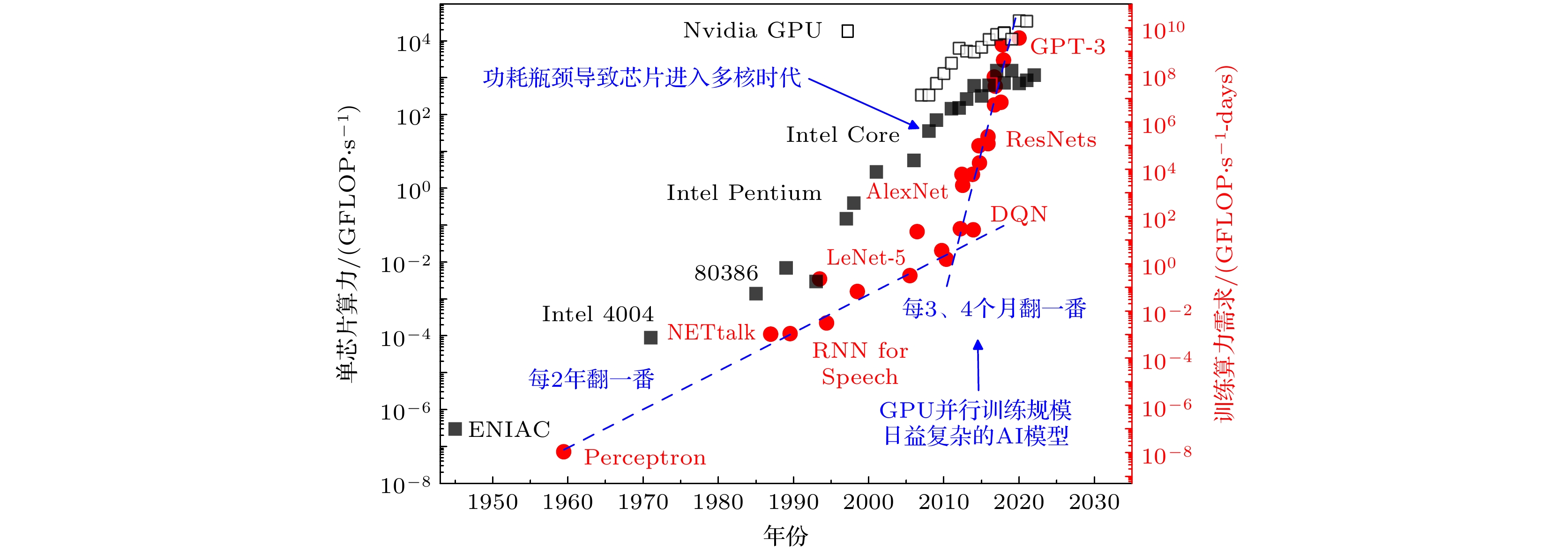
 下载:
下载:

